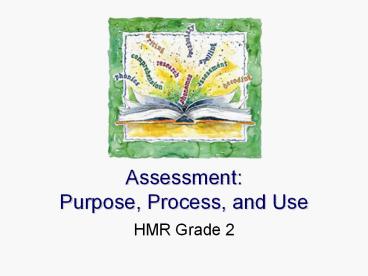Assessment: Purpose, Process, and Use - PowerPoint PPT Presentation
1 / 51
Title:
Assessment: Purpose, Process, and Use
Description:
Assessment: Purpose, Process, and Use HMR Grade 2 Without data, all anyone has is an opinion. W. Edwards Deming Ideally, assessment and instruction are ... – PowerPoint PPT presentation
Number of Views:108
Avg rating:3.0/5.0
Title: Assessment: Purpose, Process, and Use
1
AssessmentPurpose, Process, and Use
- HMR Grade 2
2
Introduction to the Assessment Training
3
- Without data, all anyone has is an opinion.
- W. Edwards Deming
4
- Ideally, assessment and instruction are linked
inextricably within any curriculum. The key to
using assessment effectively and efficiently in a
program of instruction is to recognize above all
that different types of assessment tools must be
used for different purposes. - From Reading/Language Arts Framework for
California Public Schools
5
Six Key Elements
6
Six Key Elements
- All classrooms deliver a coherent academic
program. This includes specific content and an
instructional system that is well supported with
high quality materials and training.
1.
7
Six Key Elements
- Everyone at the school uses a frequent
assessment system directly connected to the
content of the academic program. This system is
designed to be used to improve instruction.
2.
8
Six Key Elements
- All persons work in collegial, collaborative
school and grade level teams that focus on
developing successful, program-specific
strategies to improve achievement for all
students.
3.
9
Six Key Elements
- The school engages in content-specific,
site-based professional development with coaching
and technical support. Activities are developed
using the data generated by the ongoing,
program-specific assessment system and are
focused on improving instruction for all students.
4.
10
Six Key Elements
- The schools active and knowledgeable leadership
takes actions focused on developing and
strengthening the academic performance of ALL
students in the agreed academic area.
5.
11
Six Key Elements
- The district provides coherent, coordinated
support and leadership that technically assists
the school to focus work and sustain specific
improvements in achievement over time.
6.
12
Three Types of Assessments
- Screening/Entry Level
- Monitoring
- Outcome/Summative
13
Teacher and Student Materials
14
The Assessment Program
15
Skills Assessment
16
Overview ofSkills Assessments
17
Answer Keyand Directions
18
Content and Rationale Comprehension
19
Content and Rationale Checking Skills
20
Content and Rationale Spelling
21
Learning from Errors
22
Answers Theme 1 Spelling
Assessing
- base words and -ing endings
- 2. long a spellings
- 3. nd, lk, sp, nt
- 4. ou, ow
- 5. short a, i, e, o
23
Answers Theme 1 Spelling
Assessing
- long i spellings
- 7. ng, nk, ft
- 8. short a, I, u, and e
- 9. homophones
- 10. long i spellings
24
Content and Rationale Vocabulary
25
Content and Rationale Fluency
26
General Directions
27
Marking Fluency Passages
28
Theme 1 Fluency Passages
29
The Key to Reading Success
The second grade program supports fluency in
third grade by ensuring students have
automaticity with multisyllabic words.
30
Fluency Norms
31
How Many Minutes?
How many minutes does each student read aloud
every day in your classroom?
It is recommended that every child read aloud in
class 20-30 minutes every day.
32
Content and Rationale Writing
33
General Directions for Writing
34
Narrative Writing Prompt Student Page
35
Theme Writing Prompt
36
Four-Point Rubric
- conventions
- genre
- writing traits
37
Classroom Writing Assessment Report
38
Classroom Assessment Report
39
Looking at the Data
40
Look at Vertical Data
41
Look at Horizontal Data
42
Analyzing Assessment Data
43
Look at the Horizontal Data
- Student Groups
- Preteaching
- Support
- Intervention
- Accelerated/challenge
44
Universal Access
45
Identifying Students for Intervention
46
Analyzing Assessments Horizontally
47
Its All About the Teaching
- We must provide high-quality teaching with
fidelity to the core to ensure student success in
every classroom.
48
Reflecting on Instruction
- Has Direct Instruction been used?
- Has the lesson been properly scaffolded?
- Has the material been judiciously reviewed?
- Has student engagement been monitored?
49
End-of-Year Assessments
50
Next Steps
- Formulate a plan to address instructional
challenges to improve student achievement - Tackle one skill area or concept at a time
- Should help from a coach, mentor teacher, or
grade-level team member be solicited? - Would it be helpful to have the coach or
principal provide an inservice or lead a lesson
study?
51
Five-Step Process
- Teachers administer the assessments and collect,
record, and chart the vertical and horizontal
data - School meets as a whole faculty to establish the
process of using data to improve instruction - Team meetings are held to examine data and to
agree on instructional improvements - Whole school meets to share action plans across
grade levels and to develop a site-based staff
development plan - The school continues to conduct ongoing team
meetings/ lesson studies to support improved
instruction based on a written action plan































